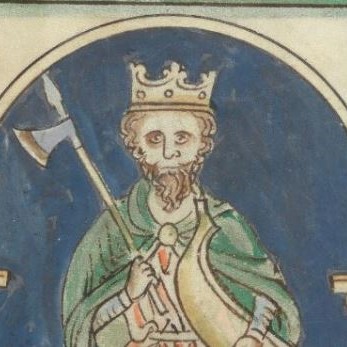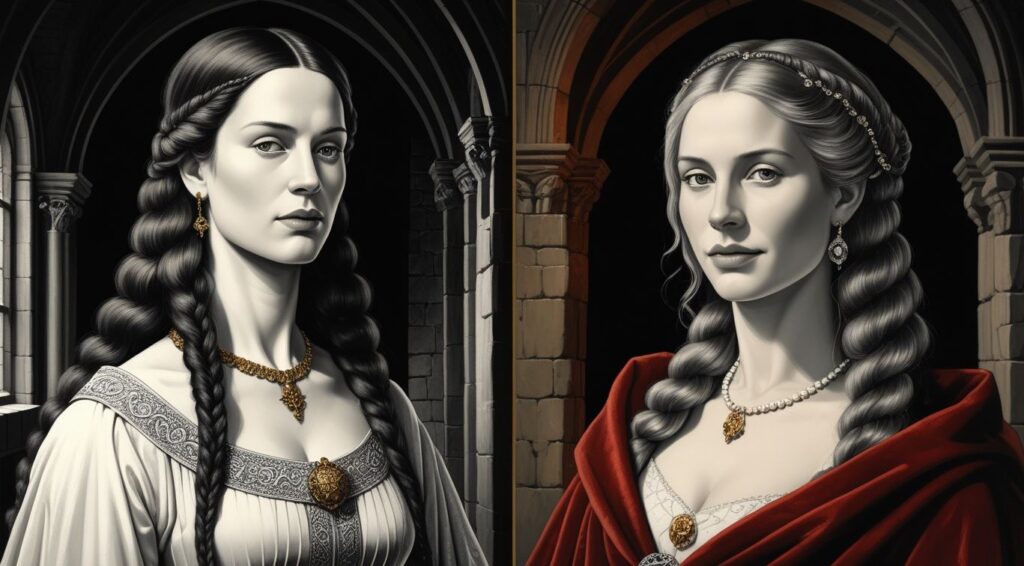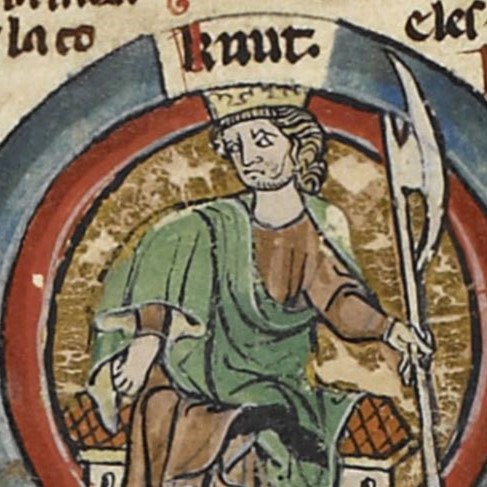England’s history is filled with controversial monarchs, but few are as complex and divisive as Richard II.
His 22-year reign (1377-1399) began with great promise but ended in tyranny and deposition.
This Plantagenet king transformed the nature of English monarchy, introducing new concepts of royal authority that were centuries ahead of their time. Yet his inability to balance power with pragmatism ultimately led to his downfall.
This is the story of a king who ruled by fear, alienated his nobles, and eventually lost everything.
- Key Takeaways: Richard II – England's Tyrant King
- Early Reign: Richard II, The Boy King
- The Peasants' Revolt of 1381
- Richard II's Personal Rule
- The Lords Appellant Crisis
- The Creation of a New Court Culture
- The Tyranny: Richard's Revenge
- The Fall of Richard II
- Henry II's Death and Legacy
- Final Thoughts on Richard II's Reign
- Further Reading
Key Takeaways: Richard II – England’s Tyrant King
- Controversial Legacy: Richard II’s 22-year reign (1377-1399) began with promise but ended in tyranny and deposition, making him one of England’s most complex and divisive monarchs.
- Revolutionary Vision of Monarchy: Richard II pioneered concepts of royal authority as sacred and absolute—ideas that wouldn’t become standard until centuries later under Tudor and Stuart monarchs.
- The Peasants’ Revolt: At just 14 years old, Richard showed remarkable courage during the 1381 Peasants’ Revolt, temporarily diffusing the crisis, but then revealed his true character by revoking all concessions and executing over 1,500 rebels.
- Power Struggles: Richard’s reign was marked by continuous conflict with the nobility, particularly the Lords Appellant, who temporarily seized control of his government in 1387-1388.
- New Court Culture: Richard developed a unique court culture that emphasized royal divinity and distance, preferring art and culture to the warrior-king tradition of his predecessors.
- Personal Vengeance: After Queen Anne’s death in 1394, Richard grew increasingly tyrannical, eventually exacting revenge against his enemies in the “Revenge Parliament” of 1397.
- Fatal Miscalculation: Richard’s decision to exile Henry Bolingbroke (the future Henry IV) and seize his inheritance proved to be his undoing, giving Bolingbroke nothing to lose by challenging the throne.
- Mysterious Death: After his deposition in 1399, Richard died under mysterious circumstances at Pontefract Castle in 1400, most likely starved to death.
- Shakespeare’s Influence: Our perception of Richard II has been significantly shaped by Shakespeare’s portrayal of him as poetic, contemplative, and ultimately tragic.
- Cautionary Tale: Richard’s story demonstrates that even innovative leadership cannot survive without compromise, restraint, and popular support.
Early Reign: Richard II, The Boy King
When ten-year-old Richard became king in 1377, England faced immediate challenges. Richard was the grandson of the mighty Edward III, whose fifty-year reign had established England as a formidable military power.
The young king’s position was precarious from the start.
Many nobles suspected that John of Gaunt, Richard’s uncle, harbored ambitions for the throne. To prevent this, England was ruled not by a traditional regency but by a series of councils meant to assist the young monarch.
Despite these safeguards, the beginning of Richard’s reign proved difficult. A series of poll taxes imposed between 1377 and 1381 created tremendous burden on ordinary people. These taxes funded unsuccessful military campaigns against France.
Financial failure combined with government corruption created a powder keg of resentment among England’s population. The situation would soon explode into open rebellion.
The Peasants’ Revolt of 1381
The final straw came in 1380 when the poll tax was tripled. This triggered what became known as the Peasants’ Revolt or Great Revolt of 1381.
Despite its name, the rebellion wasn’t led by peasants alone. Many participants were educated, ambitious individuals with local influence.
By June 1381, thousands of rebels poured into London. They burned manor houses and executed government officials.
The fourteen-year-old king was forced to seek refuge in the Tower of London.
Richard’s defining moment came at Smithfield, where he confronted the rebels led by Wat Tyler. During negotiations, Tyler was struck down by one of the king’s men. As tension mounted and violence seemed imminent, young Richard rode forward into the rebel crowd.
“I am your king,” he proclaimed, calming the rebels with promises of amnesty and justice.
This act of courage temporarily diffused the crisis.
However, Richard’s subsequent actions revealed his true character. He swiftly revoked all concessions and executed over 1,500 rebels. The king had shown that his rule would be based on fear rather than compromise.
Richard II’s Personal Rule
As Richard matured, he began asserting more direct control over his kingdom.
In 1382, he married Anne of Bohemia, daughter of the Holy Roman Emperor. Their marriage brought diplomatic advantages but no children.
The king increasingly showed favoritism to close advisors. Michael de la Pole was elevated to Chancellor and Earl of Suffolk. Robert de Vere became Duke of Ireland and the king’s closest friend. These promotions angered the established nobility.
Richard’s military expedition to Scotland in 1385 ended in failure, further damaging his reputation.
By 1386, Parliament had reached its breaking point. When de la Pole requested unprecedented taxation, Parliament demanded his dismissal. Richard famously replied that he would not dismiss even a scullery maid from his kitchen at their command.
His uncle, the Duke of Gloucester, reminded Richard of the fate of his great-grandfather Edward II – deposition and death. Reluctantly, Richard yielded to Parliament’s demands.
The Lords Appellant Crisis
Richard’s humiliation at Parliament’s hands fueled his resentment. He attempted to build a military power base in Cheshire and sought legal rulings declaring Parliament’s actions treasonous.
This provoked five powerful nobles – now known as the Lords Appellant – to challenge the king’s authority. They were led by Richard’s uncle the Duke of Gloucester, along with the Earls of Arundel and Warwick, Thomas Mowbray, and Henry Bolingbroke (John of Gaunt’s son).
At Radcot Bridge in December 1387, forces loyal to the king were defeated. Robert de Vere fled to France. Richard, now without support, was forced to submit to the Lords Appellant.
The “Merciless Parliament” of 1388 condemned Richard’s favorites. Many were executed, including his childhood tutor Sir Simon Burley. For Richard, these executions were deeply personal losses that he would never forget.
The Lords Appellant controlled the government for a year before allowing Richard to resume his authority. When the king declared his intention to rule independently in 1389 at age 22, no one stood in his way.
The Creation of a New Court Culture
During the early 1390s, England experienced a period of peace and prosperity. Richard negotiated a truce with France and seemed to coexist peacefully with his former adversaries.
This stability allowed Richard to develop a unique court culture unlike anything England had seen before. Richard reimagined kingship as something sacred and distant. He insisted that anyone who came into his presence kneel before him.
At court festivals, Richard would sit motionless for hours on his elevated throne, overseeing proceedings with regal detachment.
He preferred art and culture to military glory, breaking with the warrior-king tradition of his grandfather.
The famous Wilton Diptych, commissioned by Richard, shows him kneeling before saints and the Virgin Mary. Behind them, angels wear his personal emblem – the white hart (deer). This symbol appeared throughout Richard’s court, representing the king’s nobility and purity.
Richard built a loyal military force drawn from Cheshire. These Cheshire archers, wearing the white hart badge, became his personal guard and followed him throughout England.
The Tyranny: Richard’s Revenge
In 1394, Queen Anne died from plague. Her death devastated Richard and may have destabilized his mental state. Without her moderating influence, his more volatile tendencies surfaced.
At Anne’s funeral, Richard struck the Earl of Arundel with a staff, drawing blood – a sign of growing tensions with his nobility.
By 1397, Richard felt secure enough to strike against his old enemies. He arrested the three primary Lords Appellant – Gloucester, Arundel, and Warwick.
The “Revenge Parliament” of 1397 sealed their fates. Arundel was beheaded. Gloucester was secretly murdered in Calais before he could stand trial. Warwick was imprisoned for life.
Richard rewarded his supporters, including Henry Bolingbroke, who became Duke of Hereford. However, when Bolingbroke and Mowbray (the remaining Lords Appellant) quarreled, Richard exiled them both – Bolingbroke for ten years and Mowbray for life.
With his enemies removed, Richard established what historians call his “tyranny.” He ruled absolutely, confiscating noble estates at will. He elevated Cheshire to a principality, effectively creating his own kingdom within England.
His personal army of Cheshire archers terrorized the populace. As one chronicler noted, “for every man he chose to favor, he missed 200 others who might have loved him.”
The Fall of Richard II
Richard’s downfall came swiftly. In February 1399, John of Gaunt died. Rather than allowing Henry Bolingbroke to inherit his father’s estates, Richard extended his exile to life and seized his properties.
This fatal miscalculation gave Bolingbroke nothing to lose. When Richard departed for a military campaign in Ireland in May 1399, Bolingbroke seized his opportunity.
Landing in Yorkshire with a small force, Bolingbroke claimed he only wanted his inheritance restored. However, as he marched through England, his support grew dramatically. Most nobles, fearing and resenting Richard, either joined Bolingbroke or remained neutral.
When Richard returned from Ireland, he found his kingdom already lost. Captured and taken to London, he was imprisoned in the Tower on September 1, 1399.
Parliament accepted 33 articles of deposition against Richard. On October 1, 1399, he was formally deposed and Henry Bolingbroke was crowned King Henry IV on October 13.
Henry II’s Death and Legacy
Richard’s fate was sealed by a rebellion in his favor three months after Henry’s coronation. Though the plot failed, it convinced Henry that Richard remained dangerous even in captivity.
The former king was moved to Pontefract Castle in northern England. On February 14, 1400, Richard died under mysterious circumstances. The most plausible explanation is that he was starved to death.
Henry IV ordered an elaborate public display of Richard’s body to prove he had died naturally. After a solemn funeral at St. Paul’s Cathedral, Richard was buried secretly at Kings Langley.
It wasn’t until Henry V’s reign that Richard’s body was transferred to the magnificent tomb he had prepared at Westminster Abbey, reuniting him with his beloved Queen Anne.
Final Thoughts on Richard II’s Reign
Richard II remains one of England’s most enigmatic kings. His reign was largely peaceful compared to his warrior predecessors. However, any benefits from this peace were negated by his extravagant court and favoritism toward Cheshire.
Richard’s vision of monarchy was revolutionary. He conceptualized kingship as sacred and absolute – ideas that would become standard centuries later under Tudor and Stuart monarchs.
Yet Richard failed to understand that medieval kingship required compromise with the nobility. His vengeful nature and inability to forgive perceived insults eventually turned most of his kingdom against him.
Shakespeare’s portrayal in “Richard II” has significantly shaped our perception of this king. His Richard is poetic, contemplative, and ultimately tragic – acquiring wisdom only after losing his crown.
The real Richard was more complex: courageous in crisis, innovative in his conception of monarchy, yet vindictive and increasingly isolated from his subjects. His story serves as a compelling reminder that power without restraint or popular support cannot endure.
As Richard himself allegedly stated while imprisoned: “Yesterday the faith of 20 counties was placed in my hands, and today not a foot of land I can call my own.”
Further Reading
If you enjoyed this article, you may enjoy these:
- Kings and Queens of England Ranked from Worst to Best
- Why was Lady Jane Grey accused of treason?
- Why was the crowning of Charlemagne so important?
- Were the Princes in the Tower bodies ever found?
- What would have happened if Edward VIII had not abdicated?
- Was King John Really a Bad Ruler?
You may also enjoy these other articles:







